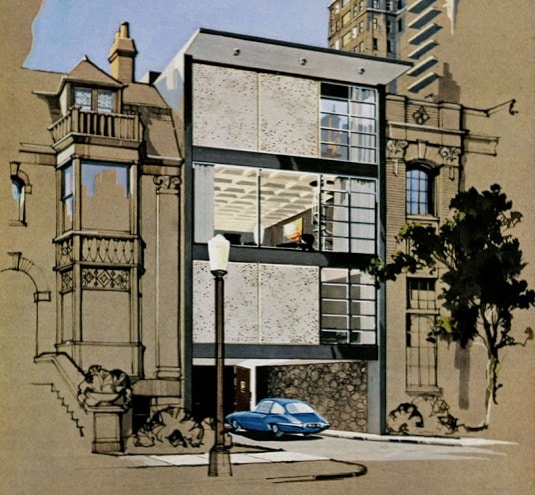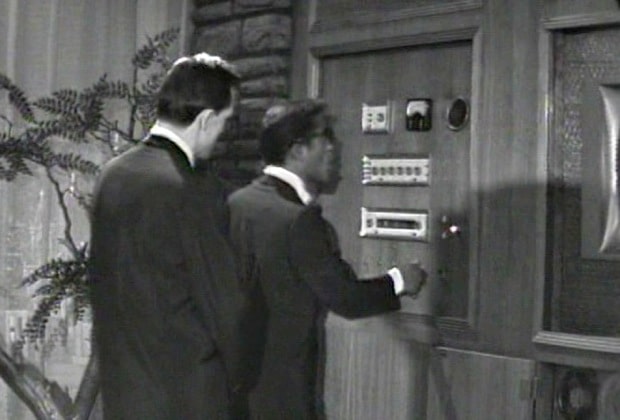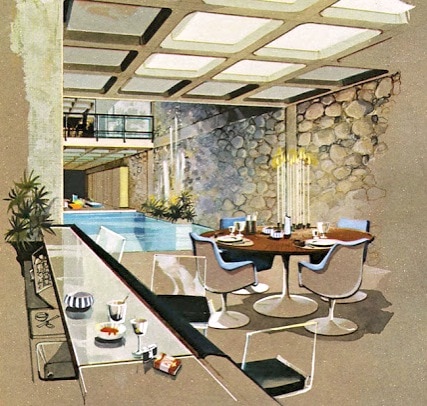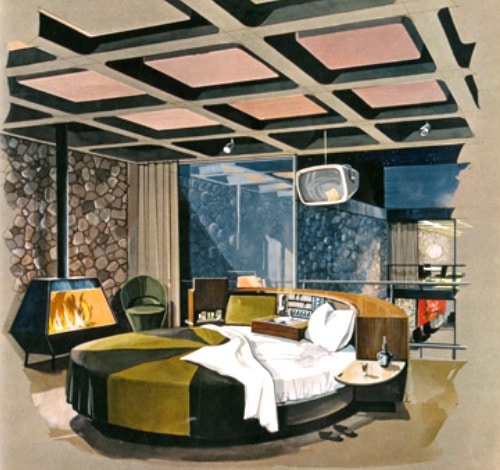Masculine Interiors - It's Time To Update Your Man Kāv

The Great Indoors: Playboy Magazine And The Invention Of The Bachelor Pad
Today we have a guest post from James Kraus of Jet Age Media.
* * *
In it’s early decades, Playboy Magazine was a gateway to the good life. Like a worldly uncle or older brother, it dispensed a cornucopia of knowledge regarding wines, cocktails, gourmet cuisine, sports cars, hi-fi gear and other adjuncts of urban living.
Prior to the publication of Playboy, the majority of men’s magazines focused on enjoyment of the great outdoors, extolling the joys of wading boots, duck blinds and clay pigeons. From the first issue, editor and publisher Hugh Hefner made it clear Playboy would be different. The magazine would focus on the urban male who tended to prefer his entertainment indoors. Hefner stated, “We don’t mind telling you in advance – we plan on spending most of our time inside.”
Playboy kept its word. Not only did they spend their time indoors, their indoor spaces tended to be sleek and up-to-date. From the beginning, Playmate pictorials were enhanced with the latest modernist furniture creations from Bertoia, Eames, Saarinen and other highly esteemed Mid-Century designers.
The very first issue contained a feature piece on Desk Design For The Modern Executive. The recurrent Modern Living series spotlighted the latest in a-la-mode furnishings. From there, it was a natural progression for Playboy to eventually segue into designing entire bachelor pads.
The bachelor pad was a fairly new construct. Prior to the 1950s, young men usually progressed directly from family home or university dormitory directly to married life in a shared home where the wife was typically in charge of décor. As young men began moving into personal dwellings of their own, a trend accelerated dramatically in the 1960s, they had little in the way of guidance as to how to formulate a presentable ambiance. Often, they were misguidedly told that their new domicile just needed a women’s touch!
The stage was thus set for Playboy to provide some much needed guidance. The first fully realized Playboy environment was the Penthouse Apartment, featured in the September and October 1956 issues. Articulated in the feature article was the statement of purpose: A man yearns for quarters of his own. More than a place to hang his hat, a man dreams of his own domain, a place that is exclusively his. Playboy has designed, planned and decorated, from the floor up, a penthouse apartment for the urban bachelor.
Two key features were incorporated into the penthouse that would become standard features of future Playboy architecture: couch and bedside control panels for various gadgets, and the entertainment wall housing hi-fi gear and a television, a precursor to today’s ubiquitous entertainment center.
Obviously conceived to accommodate the bachelor of means, the penthouse appears to be at least 1,800 square feet in size. Exposed brick walls and dark wood panelling added a dose of both modernism and masculinity. Aids to seduction included multiple built-in bars, ample wine storage, and lamps on timed dimmers allowing rooms to slowly darken as evening wore on. The dining room was designed to be ideal for a gala dinner or all-night poker game —stag or strip.
The Playboy bedroom contained a lounging area with a Saarinen womb chair (an early playboy favorite), a Noguchi coffee table, and a cowhide-covered Eames plywood LCW chair. For Playboy readers who just wanted to procure a few highlights of their own penthouse, a buying guide was included, separately listing the manufacture and pricing of the items rendered. Princeton University Architectural historian Beatriz Colomina later observed that Playboy made it acceptable for men to be interested in modern architecture and design. Readers were encouraged to think they could have a piece of the idealized interior in their own lives.
Here Hugh Hefner instructs Sammy Davis Jr. on the nuances of operating the 1959 iteration of the entertainment wall on the set of the TV show “Playboy’s Penthouse”:

Playboy’s most famous and well-documented architectural project was the Playboy Town House proposal detailed in the May 1962 issue. The extravagance and level of detail is no surprise as it was originally envisioned to be the bachelor pad of Hefner himself.
Designed by architect R. Donald Jaye, the design incorporated all the tenants of modernism; 1960s style, with the usual Playboy emphasis on masculine detailing, this time making extensive use of rugged fieldstone walls and extensive teak wood panelling. The exterior façade was a composition of glass, structural steel and exposed-aggregate concrete (see top image).
The living room featured a baronial Spanish cabinet containing a built-in bar flanked by a pair of Laverne T-Chairs. Above hangs De Kooning’s oil on paper “Duck Pond.” Across the room sits a rare Laverne tulip chair in white next to a mammoth fireplace, surrounded by the ubiquitious entertainment wall containing built-in hi-fi gear, speakers and a 21” color television. When not in use, the TV was concealed by teak panels. The poured concrete waffle-pattern ceiling overhead was a common feature utilized throughout.
The dining room contained a Saarinen walnut-topped pedestal table with matching fully-upholstered armchairs. Situated to the left was a bar useful for pre-dinner libations or causal snacking. The man of the house and his comely companion could choose from dining al fresco overlooking the atrium pool and fountains, or close the electrically operated curtain to facilitate a more intimate environment.
The heart of the Town House, the master suite, contained the most signature item in the entire structure: the infamous Playboy motorized rotating circular bed with built-in bar, refrigerator, entertainment system and remote controls. In the corner, a green Panton cone chair, and overhead, a television suspended from the ceiling.
The entertainment wall was once again revisited and updated in 1966 with a heavy focus on reel-to-reel audio tape reproduction, taking advantage of their four-hour plus uninterrupted playing time. In the foreground, an Eames aluminum group lounge chair.
In a Playboy essay published in 1958, Philip Wylie observed that the typical American home was becoming a boudoir-kitchen-nursery, dreamed up by women, for women. The Playboy Penthouse and Town House provided a ready antidote, with their spatial manifestation of masculinity and the absence of bric-a-brac, patterned fabrics, pleats and ruffles. The 1960s Playboy architectural philosophy instead celebreated rugged materials, simplicity of design, carefree maintenance and lots of clever labor-saving gadgetry. These were the common threads that unite all the Playboy proposals from the decade. The timelessness of their design language is reflected in the fact that, except for the laverne tulip chair, of all the furniture pieces mentioned above remain in production today. — JAMES KRAUS





7 Responses